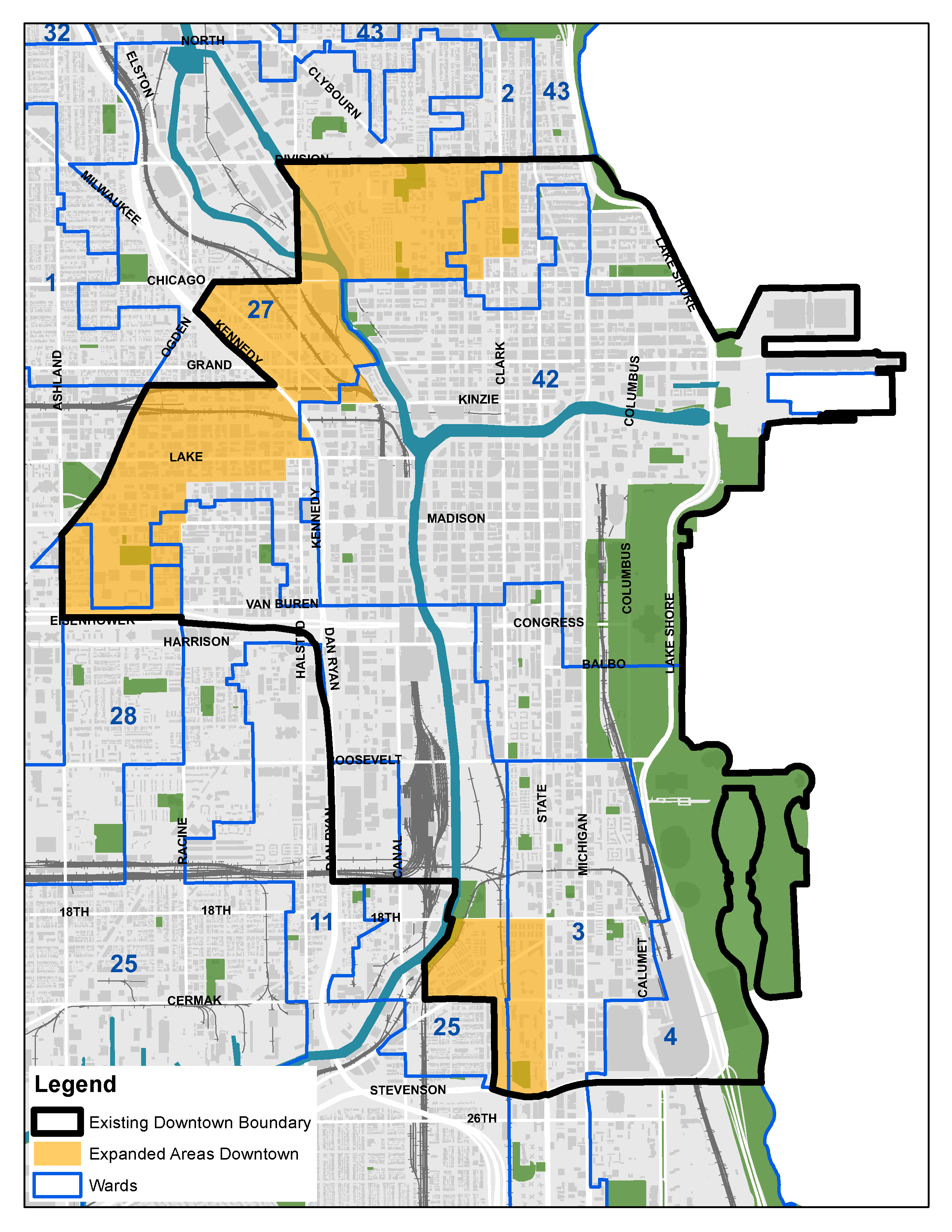Neighborhood Opportunity Bonus: Leveraging Downtown Zoning to Foster Neighborhood Development and Central Area Growth
Updates to the Chicago zoning code's downtown floor area bonus system and downtown zoning district geography were approved by City Council in May 2016. Coordinated as the Neighborhood Opportunity Bonus, the changes simplify and update the downtown floor area bonus system; accommodate ongoing central area growth through an expanded downtown zoning district; and provide new funding sources to encourage commercial development in neighborhoods lacking private investment.
The main components of the Neighborhood Opportunity Bonus ordinance are identified below.
Downtown floor area bonuses
Zoning bonuses to increase the size of individual downtown construction projects are allocated through a higher floor area ratio (FAR), which reflects the total square footage of the building divided by the area of the lot. FAR bonuses are available through a single voluntary payment into a Neighborhood Opportunity Bonus system. Previous provisions in the zoning code were regulated by a 2004 ordinance that identified a variety of on-site amenities, such as building setbacks, wintergardens, green roofs and other design features.
The equation for determining the bonus payment under the simplified system is as follows:
- Cost of 1 square foot of floor area = 80% x median cost of land per buildable square foot
For example: For a hypothetical buildable square foot cost of $43, the bonus contribution equation would be 36,000 square feet multiplied by 80% of $43 ($34.40).
- 36,000 x $34.40 = $1,238,400
New construction projects seeking FAR bonuses are processed as Planned Developments, a zoning designation that provides additional public scrutiny for proposed construction projects. The review process for new projects will also be further refined to foster excellence in design and the inclusion of public amenities.
Downtown (D) zoning
Chicago's central area has its own downtown (D) district designation due to its unique attributes as the employment, transportation, cultural, and residential nexus of the region. Ongoing development has expanded the geography of these characteristics beyond the established boundaries of the district since it was designated at the turn of the century.
To appropriately address and accommodate ongoing central area market pressures, four areas along the perimeter of the district are eligible for potential D district zoning. Each area is well-served by public transit and possess other features that align with the development patterns of the downtown area. Individual maps of the proposed areas are below. Specific applications and FAR requests will be reviewed in accordance with applicable standards, and no FAR maximum is guaranteed. Applicants will need to demonstrate conformance and/or compliance with area plans and guidelines published by the Department of Planning and Development.
West - Northwest - North - South - North Branch
Construction projects within the expansion areas may apply for a D district zoning designation that appropriately reflects the size and scale of nearby properties and ongoing development trends. If each project is approved for the D district designation by the Chicago Plan Commission and City Council, additional density will be made available through the Neighborhood Opportunity Bonus which, in turn, would allocate funds for under-served neighborhood commercial districts, designated landmarks, and local infrastructure.
Neighborhood Financial Support
Payments for FAR increases are allocated into three new development funds described below.
Neighborhood Opportunity Fund: Receives and allocates 80 percent of all bonus contributions to support development projects within under-served West, Southwest and South side commercial corridors, including grocery stores, restaurants, and cultural facilities.
Citywide Adopt-A-Landmark Fund: Receives and allocate 10 percent of all bonus contributions to support the restoration of structures designated as official landmarks by City Council.
Local Impact Fund: Receives and allocate a 10 percent of all bonus contributions to support improvements within one mile of the development site generating the development funds, including public transit facilities, streetscapes, open spaces, river walks, and other sites, including landmarks.
Changes to the Chicago zoning code's text and map require a public review and approval process that may include the Chicago Plan Commission as well as the Chicago City Council.
For questions or comments about the Neighborhood Opportunity Bonus, please email dpd@cityofchicago.org.
Supporting Information Facts
Department:
People We Serve:
Additional Information

RELATED RESOURCES
Neighborhood Opportunity Bonus 2024 Report
Neighborhood Opportunity Bonus 2023 Report
Neighborhood Opportunity Bonus 2022 Report
Neighborhood Opportunity Bonus 2021 Report
Neighborhood Opportunity Bonus 2020 Report
Neighborhood Opportunity Bonus 2019 Report
Neighborhood Opportunity Bonus 2018 Report
Neighborhood Opportunity Bonus 2017 Report
FAR Bonus Worksheet - to be completed at time of Part II submission only (Excel)
Standard plan development language for utilization of Neighborhood Opportunity Bonus (Word doc)
